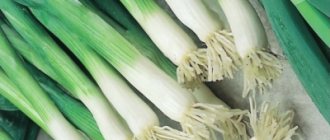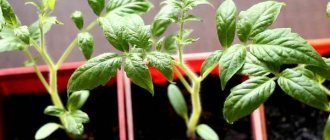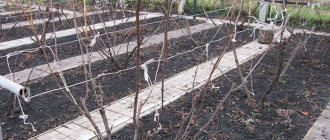What it is ?
Winter garlic, mainly used for this method, has one distinctive feature: when it grows, arrows appear on it, which, in the process of further growth, open up and become like a lush flower, consisting of many voluminous petals. These petals are the bulbs - very small cloves of garlic. On one stem their number can reach hundreds.
The aerial bulbs look like seeds and are used for planting garlic. So, in order to get 100 - 150 garlic heads, it is enough to leave about 3 sprouted shoots.
How to prepare for landing
First of all, you need to understand how best to get the expected bulbs. First you need to shorten the arrows of the winter plant, just so that they are well ripened. The vegetable itself germinates in March, and numerous shoots form by the end of May.
It is best to cut off the arrows with the arrival of June, since this is the ideal period for the seeds of winter garlic to grow freely, and for the crop itself to be larger in size. To obtain high-quality bulbs, the shoots should be cut off somewhere at the end of June, after the 20th. By this period, the film under which the aerial bulbs form will dry out and crack - this is a sign to remove the stems. When finished, you will need to dry them thoroughly in the shade. Bulbs can be stored for 2 years without losing their qualities.
Features of planting using bulbs
The winter type of garlic attracts everyone who is involved in planting such crops with its amazing yield and large size of heads and, accordingly, cloves as well.
But during subsequent planting, their size is a huge disadvantage, because in order to get a large amount of harvest, you will also need a lot of planting material.
It is important to note that in one head of winter varieties there are on average 12 cloves, in spring varieties - up to 20 .
It is very irrational to waste most of the grown garlic in order to plant it again. Therefore, the way out of this situation was to grow garlic from bulbs.
But the main advantage is not the saving of planting material, but the improvement of the entire crop (during the process of their growth they do not touch the ground, and therefore are not carriers of any diseases) and an increase in its shelf life.
The difference from other methods of growing garlic is a significant simplification of the process : when planting cloves, you need to put one in each hole, and the bulbs just need to be placed like the seeds of any other vegetables.
Growing vegetables from cloves
This method is the most famous. And how to grow garlic from seeds? To do this, first of all you should choose the right location. The best crops are considered to be beds after legumes, cucumbers and cabbage, the worst - after potatoes and onions. It is recommended to plant a garlic plant in the same place only after 3-4 years.
Before planting, you will need to add fertilizing (rotted manure or compost) to the soil. This should be done in the fall. Then you need to prepare the bulbs, carefully examine them, remove the spoiled ones and separate them. This is done just before landing. The vegetable is planted approximately a month before persistent cold weather. This should be done so that the crop has time to take root, but does not sprout.
How many seeds are in 1 kg?
On average, the number of bulblets on one inflorescence varies from 20 to 130; after collecting and drying, the mass of this quantity is 12 - 20 grams, and this allows us to calculate that 1.5 - 2 tons can be collected per hectare with a density of 150 - 200 seeds plants per 1 hectare.
1000 bulbs weigh approximately 120 - 400 grams, so 1 kg. There can be a minimum of 830 pieces . Their number can be either more or less. It all depends on the variety of winter garlic and growing conditions, so this number should not be considered accurate.
Choosing a landing site
To plant garlic by seed, you need clean, disease-free, fertile soil. Seeds from bulbs are sterile and cannot resist infections.
It is strictly forbidden to plant garlic in the same place for 2 years in a row; diseases can accumulate in the soil. It is also not recommended to plant garlic in a place where onions, cucumbers and carrots previously grew, but after peas, tomatoes and cabbage it will even be useful.
When and how to collect seed?
Each region has a different time for garlic to ripen, so you can determine when you need to collect the bulbs by the appearance of the arrow: first it will curl into a spiral, and then straighten out, then you need to start.
It is best to choose bulbs on the largest shoots in order to get a good harvest later. Having left them, we get rid of all the rest and wait for the ripening of those that we have chosen.
In no case should you miss the moment of full ripening of the bulbs, because immediately after this they will begin to actively fall off.
The collected bulbs do not need to be separated from each other, because they are stored whole, wrapped for some time in gauze (pre-soaked in a solution of potassium permanganate and already dried) and hung to ripen.
At this time, there is an influx of all nutrients from the stem into them.
When the stem has dried significantly, you can pull the bulbs out of the gauze and separate them from each other, which will be much easier to do. Then they can be stored until the next planting or they can already be planted.
From the video you will learn when to collect garlic bulbs:
Pros and cons of growing garlic from seeds
The positive aspects of this method include the following points:
- The bulbs with seeds do not come into contact with the ground, this eliminates the possibility of infection of the planting material with various diseases.
- This method is the most preferable for propagating garlic.
- With the seed propagation method, all varietal qualities and characteristics are preserved.
- Garlic seeds are much faster and more convenient to plant in the soil than cloves.
- With the seed planting method, the germination level is quite high.
The seed method of planting garlic also has disadvantages:
- A full harvest can be obtained only after 2 years.
- During severe frosts, there is a risk of seeds freezing.
Step-by-step instructions on how to grow a crop
Sowing time
Choosing the right time to plant garlic in this way is very important, because it can be done both in autumn and spring. In autumn, it is best to plant bulbs in September or October , then they will have time to take root well before the cold weather arrives.
And in the spring, as soon as you can start planting something (for example, you can focus on the beginning of work in the field), but even then the yield will be less compared to what will appear as a result of autumn sowing.
Inventory preparation
Due to the fact that planting garlic using bulbs occurs in the same way as planting any vegetable using seeds, various mechanisms can be used during this process to further simplify it. A conventional onion seeder (SLR – 2) is suitable as a manual technique. With its help you can change the distance between the holes. For large sowing areas, only Spanish machines are offered on the Russian market at reasonable prices.
Preparation of material
It is recommended to place the bulbs on the bottom shelf of the refrigerator 2 - 3 months before planting to harden them and prepare them for outdoor conditions; you can also soak them in the hall solution for 12 hours and plant them immediately after that. Full instructions are described below.
Site selection
To grow garlic from bulbs, you need clean and fertile soil, because... they do not have a good ability to resist disease. You need to cultivate the land before planting in the same way as for any other method of growing this crop.
Important! Before planting, you need to level the area as much as possible.
The process of planting an air seeder
There are no fundamental differences in how to plant garlic using bulbs in small gardens and large areas, only in the technology that is used for this: either a manual seeder or large sowing machines. The methods are also the same: in winter or spring – it doesn’t matter.
Before planting, the bulbs are sorted by size into 3–4 groups, and on average 30–40 pieces the size of a match head are needed per 1 square meter. m. Accordingly, the larger their size, the greater the quantity required. The sowing depth is 3–4 cm in spring and 10 cm in autumn , and the distance between rows (they can be of any length, depending on the area) is 3 cm.
Next, the seeds placed in the ground are covered with a layer of humus and left alone.
You can get a full-fledged large head of garlic only in the 2nd year of sowing . In exceptional cases, this can happen for 1 year.
It must be remembered that under no circumstances should you grow garlic in the same area for more than 2 years in a row. Diseases can accumulate on this land, and you should not place a planting area where onions, cucumbers, and carrots were previously grown. It is best to do this after tomatoes, any cabbage and peas.
See how to plant garlic bulbs using this technique:
Care
Caring for bulbs planted in spring consists of watering, fertilizing, loosening the beds and getting rid of emerging weeds. When the first shoots appear, you need to immediately loosen the soil to avoid the appearance of a soil crust, which noticeably slows down growth, and cover it with a layer of humus or peat. And watering should be regular from the beginning of May to the beginning of July. And stop moistening the soil 3 weeks before harvesting.
Bulbs require almost no care in the spring, so it is important to choose those that are large and healthy for sowing at this time of year.
After the snow melts, the first shoots appear , and they are fertilized, watered and weeded, but not dug up. And already in the 2nd year something grows that is suitable for obtaining a full-fledged harvest.
You can read general information about caring for garlic here.
Harvest and storage
Winter garlic, planted in spring or autumn, is usually harvested in mid-July. But for the most part, you need to focus not on the timing, but on the yellowing of the leaves, the scales on the bulb becoming dry.
Features of garlic agricultural technology
After the first shoots appear, you must:
- loosen the rows;
- thin out the grooves;
- remove weeds.
A set of such events is carried out once every 2-3 weeks. Garlic plantings are watered as needed with clean, warm, settled water. Approximately one month after the first sprouts appear, the garlic is fed. It is important to apply mineral fertilizers; as a rule, superphosphate is used.
In order to protect crops from pests, onion beds are periodically sprinkled with ash or mustard powder after rain. Mulching with humus is carried out immediately after planting.
Possible problems and difficulties
There is absolutely nothing complicated about growing garlic bulbs: they appear on their own as soon as the top layer of the bulb dries and cracks. They are also easy to dry: just wrap them in gauze and hang them to fully ripen.
We suggest reading other useful articles about garlic:
- Varieties.
- Growing garlic as a business.
- Feeding.
- Seed treatment.
Care after landing
- In winter, you need to make sure that there is enough snow on the beds, otherwise the seeds may freeze. Snow must be transferred from other places to the garlic beds.
- From May to July, garlic crops must be watered regularly; watering should be stopped 3 weeks before harvest.
- Garlic needs feeding. In mid-April, nitrophoska is added at the rate of 15 g per 1 square meter. m, and in June they add ammophoska in the same quantities.
- It is necessary to regularly remove weeds and shallow loosen the soil in the beds.
- It is necessary to trim off excess arrows, which can significantly reduce the yield, in June. They are simply carefully broken out when the garlic grows to a height of 5-8 cm.
- Since garlic has bactericidal properties, it can be planted next to other plants that it can protect from diseases.
When to plant bulbs
Garlic seeds do not require pre-planting preparation: they are healthy and not affected by infection. Larger specimens are selected for breeding: the best one-toothed ones ripen from them, which are then used to propagate the variety. When to plant, immediately, in the fall, or after wintering, in the spring, is a matter of taste. Although more often the bulbs are sent to open ground a month and a half before the onset of winter cold.
Planting in autumn
Following the planting pattern on the site, in the fall they choose a bed after beans or peas, zucchini and pumpkins. After summer cabbage, even green manure has time to sprout - also a suitable platform. In terms of timing, residents of the Urals and Siberia are guided by mid-September. In central Russia, garlic is planted towards the end of the month. If autumn is warm, then the planting season extends until mid-October. Weather forecasts for the current season help determine the time correctly.
Preparation of the bed begins a week before planting. They dig up the soil using a shovel bayonet and add organic matter or a mineral complex. The bulbs are planted according to the usual pattern for winter varieties with the only difference: the distance between the small seed cloves is smaller - 3-5 cm. This gap is sufficient if they have to be transplanted next fall. And the depth is the same. That is, the diagram is 3-5cm X 3-5cm. In clay soils it is slightly higher, in sandy soils it is deeper. But within the designated limits.
If at the end of next summer the gardener does not plan to dig up the one-toothed garlic (they can be left over the winter, and a year later the harvest of full-fledged garlic can be harvested), then either they are planted at large intervals or thinned out. This can be done every other year in the fall, when weak plants are visible. They are removed.
Is it possible to plant garlic bulbs in spring?
Doubting that small cloves will not survive frosts in the ground, some gardeners from northern regions plant bulbs in the spring. But the bed is still prepared in the fall: they dig it up, loosen it, and fertilize it. So that immediately after the snow has melted and the ground has warmed up a little, prepare the planting sites. By covering the soil with a film or black agrotextile, the soil warms up faster.
The bulbs also need to be prepared for planting. The step-by-step diagram looks like this:
- One and a half to two months before the planting date, the air bags are taken out and calibrated, selecting dense, strong cloves.
- Place in the refrigerator for up to 6-7 weeks. Cooling is necessary for the subsequent awakening of the seeds. The procedure is called stratification.
- On the eve of sowing, soaking in water (a quarter of a liter) with ash (salt, potassium permanganate - your choice) will allow you to reject non-germinating (floating) air and at the same time slightly disinfect and harden the planting material. You will need a tablespoon of ash. Add tea salt. Potassium permanganate - until pink.
Dates for planting spring garlic:
- late February-early March in the southernmost regions;
- March-mid-April warm regions of the Volga region;
- second half of April – Middle and Central Russia;
- May holidays – Ural, Siberia.
The scheme is the same as for winter planting of bulbs.
Harvesting
Garlic is harvested when its leaves begin to turn yellow, usually around August. You can dig up one bulb for testing and inspect it - it should be developed and dense. Gardeners believe that it is better to harvest the crop ahead of schedule than to keep it in the ground. Immature bulbs can easily ripen at home.
You need to dig up the bulbs with a pitchfork, do not tear off the leaves, and cut off the arrows. The dug up bulbs are laid out to dry for several hours under the sun. When the leaves become dry, they can be shortened a little and braided for storage.
If you need to dig up single-toothed plants as future seed, then they are collected when the tips of the leaves have just turned yellow, but not later. One-toothed bulbs should not be left in the soil; the bulb may become deeper, and this will lead to a reduction in yield in the future.
After collection, the single-toothed mushrooms are dried well, then the roots and stems are removed, sorted by size and stored in a dry, dark, well-ventilated room.
Preparation
The end of July to mid-August is the most favorable period for collecting and preparing for long-term storage of garlic bulbs. The ripe heads are cut off at the base with a sharp knife. Under no circumstances should you pull out or break off the stems, as this can harm the plant.
The bulbs are carefully sorted, separating large cloves from small ones. The collected seed material is carefully placed in a clean cardboard box, and then sent to a dark, dry place for drying.
To prevent the seed material from becoming covered with mold and mildew, it is very important that the room is dry and the air temperature is constantly maintained at least +18°C.
It is easy to understand that the bulbs are ready for further long-term storage: the seed heads will begin to crack and crumble. How long do garlic seeds last? Bulbs can be stored for six to seven months.
How to plant plants
In order for planting garlic seeds to be successful in the future, you need to prepare the beds a week in advance. This is done so that the soil does not have time to sink (in damp soil the cloves will settle very deeply). The interval between the cloves should be at least 8-10 cm, the space between the lines should be 40-50 cm. After planting, it is ideal to cover the ground with sawdust or peat, so the vegetable will better survive the frosts. However, if the winter is warm and not very severe, you can do without powder.
Spring planting is not very different from winter planting: only its approximate depth is 5 cm, and the distance between rows is 25-30 cm.
Spring planting technology
When using garlic seeds in the spring, you need to know how to plant so that the crop has time to gain the necessary strength. To carry out the procedure you need to perform the following steps:
- beds for planting crops must be prepared in the fall - for this, the area is dug up and leveled with a rake;
- The grains must be peeled from the shell a few weeks before planting in the ground and placed in the refrigerator in the vegetable compartment (this action is necessary for hardening the crop);
- It is necessary to plant grains in early March, when the soil warms up a little. However, spring garlic can be planted later if weather conditions do not permit;
- The grains are planted evenly on the beds and covered with soil.
After planting using this method, seedlings appear very quickly, but it is necessary to carefully monitor the condition of the sprouts and carry out timely watering. Also, after germination, it is necessary to regularly loosen the soil and promptly remove weeds. The crop can be grown on all types of soil.
Important! In order to facilitate the planting process, the bed can be covered with film in the fall so that the soil does not freeze too much.
Reasons for delayed ripening of bulblets
The ripening of bulblets may be delayed, and sometimes the seeds do not ripen at all. This is influenced by several factors:
- Using low-quality planting material. If the cloves were deformed or had signs of disease, the crop will not fully develop, the growing season will be delayed, or the seeds will not be able to ripen properly.
- Bad land. The development of garlic is affected by the structure and acidity of the soil. In acidic, heavy soil, plants will shoot arrows with a delay.
- Drought. Garlic requires quite a lot of moisture to grow properly. Poor watering leads to slow development of the crop.
- Diseases and pests. Any disease (fusarium, rust, rot) or parasitic insects weakens the plants, which causes growth inhibition. In advanced cases, the culture may even die.
All these reasons should be eliminated in advance. It is necessary to follow the rules of crop rotation, planting garlic after suitable predecessors (potatoes, early and cauliflower, zucchini, squash, legumes, green manure, pumpkin), then the likelihood of disease will be less. Acidic soil must be limed. For looseness, peat, river sand, and vermiculite are added to the soil. The garlic bed is watered in a timely manner.
Timing for harvesting air bulbs
Garlic seeds are often planted in the winter (in spring varieties, the formation of shoots begins much later and the bulbs do not always have time to ripen). For planting, select large bulbs containing at least 4 cloves. You need to wait until the formation of flower stalks begins, and leave the inflorescences on the strongest and healthiest plants.
In the conditions of the Moscow region, most varieties produce ripened seeds in mid-July; for late varieties, the date shifts to early August.
The ripening period depends on weather conditions and the region where garlic is grown. In cold climates, the soil warms up later, which means plant development is delayed.
To harvest the seeds, it is enough to leave 2-3 garlic arrows. From them you can get 100–150 bulbs for planting.
Closer to harvesting, you should monitor the plants. The following signs will indicate the maturity of garlic and bulbs:
- the spiral-curled arrow straightens;
- the leaves turn yellow and begin to wither;
- the film covering the aerial bulbs bursts.
You should not overexpose ripe inflorescences in the garden, otherwise the bulbs may crumble.
On plants from which it is not planned to collect seeds, the shoots are cut off at the very beginning of formation so that all the forces of the garlic are directed to the growth of the heads.
If the inflorescences were left for seeds, they must be cut off at the right time. The bulbs left on the shoots after ripening fall to the ground on their own; next year the garlic will germinate by self-sowing in conditions that are contrary to the agricultural practices of the crop. The distance between plants will be less than required, which will interfere with their normal development.
Propagation of garlic by bulblets
You can propagate garlic using bulbs constantly, leaving shoots with aerial bulbs every year. Planting is done twice a year. You just need to decide when to sow the garlic bulbs - in autumn or spring.
And the family will eat vegetables all year round, nourishing themselves with vitamins and beneficial elements. The diet can include both leaves and stems of the vegetable, which contain many microelements. With this method of propagating garlic, the gardener will not be left without a useful vegetable.
Sources
- https://profermu.com/ogorod/chesnok/semena.html
- https://uddasha.ru/posadka-chesnoka-bulbochkami/
- https://OgorodGuru.com/ovoshhi/semena-chesnoka
- https://nashsadovod.ru/chesnok/kak-iz-bulbochek-vyrastit
- https://rufazenda.ru/kak-vyirastit-chesnok-iz-bulbochek.html
- https://prodachnika.com/ogorod/vyrashhivanie/kak-vyrastit-chesnok-iz-bulbochek-letom-i-zimoj.html
- https://DachaMechty.ru/chesnok/kak-iz-bulbochek-vyrastit.html
[collapse]
Favorable days for planting garlic in 2022 according to the lunar calendar
The dates were selected according to the gardener's lunar calendar for the current year and are suitable for planting both garlic (spring and winter).
Planting spring garlic (in spring)
| Month of 2022 | Favorable days | Prohibited days |
| April | 1, 3, 5, 8, 9, 28 | 11, 12, 13, 27 |
| May | 2, 5, 6, 28 | 10, 11, 12, 26 |
Planting winter garlic (autumn)
| Month of 2022 | Favorable days | Prohibited days |
| September | 10, 11, 12, 13, 14, 15, 16, 24, 25 | 6, 7, 8, 21 |
| October | 8, 9, 10, 11, 12, 13, 21, 22 | 5, 6, 7, 20 |
| November | 7, 8, 9, 17, 18 | 4, 5, 6, 19 |
Advantages and disadvantages of air landing
The benefits of planting bulbs are obvious:
- rejuvenation of garlic, preservation of the variety. After four or five years, garlic degenerates if it is planted with cloves year after year from the same plants;
- since the bulbs do not contact the ground, they do not become infected with fungi and diseases, the pathogens of which are found in the soil;
- there is a lot of planting material, from 40 to 100 bulbs grow on one arrow.
Disadvantages of this method:
- large heads of five to seven cloves will appear only after two years;
- some of the seed material will inevitably dry out in winter, so you need to leave more bulbs than you need to plant your beds;
- sprouts made from tiny cloves are very delicate and fragile, they are easily clogged by weeds, and must be weeded very carefully.











